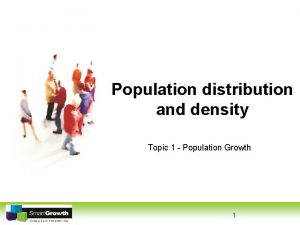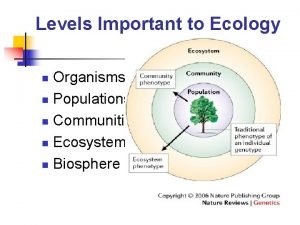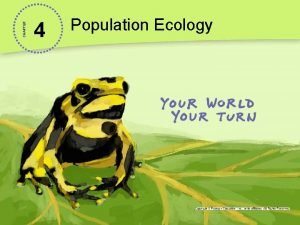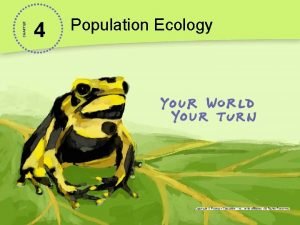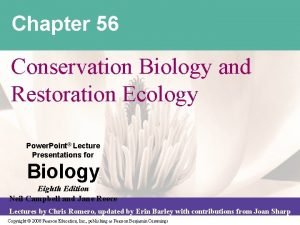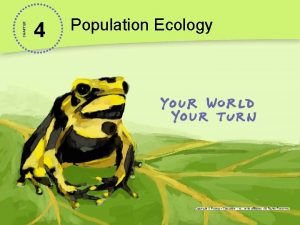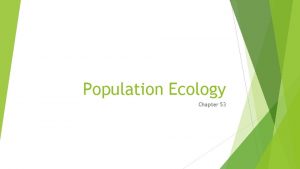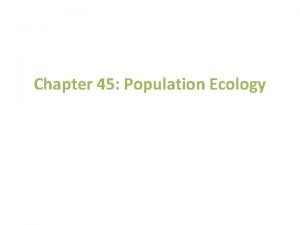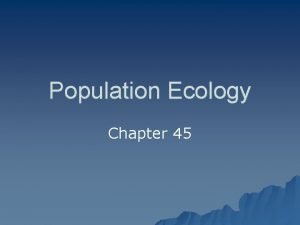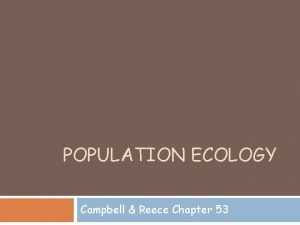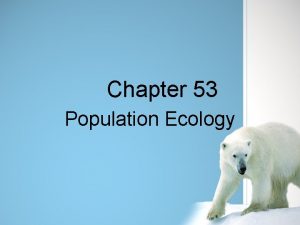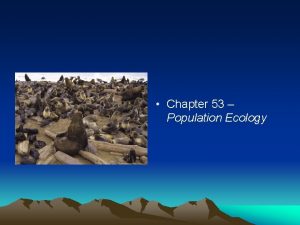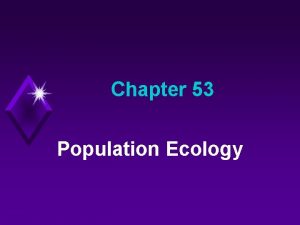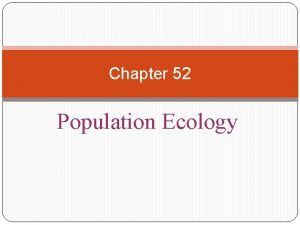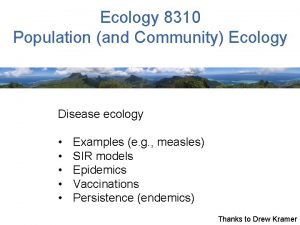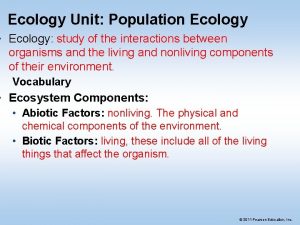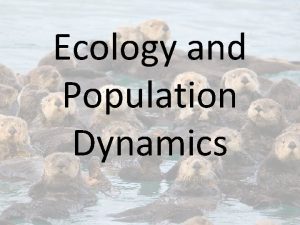CHAPTER 4 Population Ecology Finding Gold in a


























- Slides: 26

CHAPTER 4 Population Ecology

Finding Gold in a Costa Rican Cloud Forest • Golden toads lived in Costa Rica’s Monteverde cloud forest. • Golden toads were first described in 1964. They were extinct by 1989. Talk About It Why is the extinction of the golden toad a global concern?

Lesson 4. 1 Studying Ecology Ernst Haeckel defined ecology in 1866 as “the body of knowledge concerning the economy of nature—the total relations of the animal to both its inorganic and organic environment. ”

Lesson 4. 1 Studying Ecology Levels of Ecological Organization • The study of how organisms interact with each other and with their environments • Scientists study ecology at various levels of organization.

Lesson 4. 1 Studying Ecology Biotic and Abiotic Factors • Biotic factors: Parts of an ecosystem that are living or used to be living • Abiotic factors: Parts of an ecosystem that have never been living Did You Know? Decaying organisms are biotic factors as long as their structure remains cellular.

Lesson 4. 1 Studying Ecology Habitat • The specific environment in which an organism lives • Habitats provide an organism with resources—anything an organism needs to survive and reproduce, including food, shelter, and mates.

Lesson 4. 2 Describing Populations From 1900 to 2000, the white-tailed deer population of New York state grew from about 20, 000 to more than 1 million. Densities of more than 100 deer per sq mi occur in some metropolitan areas.

Lesson 4. 2 Describing Populations Population Size • The number of individuals in a population at a given time • Sudden and dramatic decreases in population size can indicate an unhealthy population headed toward extinction. • Golden Toad population in Monteverde • 1987: 1500 toads • 1989: 1 reported • 1990: extinct

Lesson 4. 2 Describing Populations Population Size • Decline of the Passenger Pigeon • Once the most abundant bird in North America • Studied by Ornithologist Alexander Wilson in 1800 s • Flock of 2 billion formed a mass 390 km (240 mi) long and took 5 hours to fly overhead • Nested and bred in forests of upper Midwest and southern Canada – deforestation occurred, easier for hunters to kill birds • By end of 1800 s, population so small they could not form large colonies for breeding • In 1914 last pigeon died in the Cincinnati Zoo

Lesson 4. 2 Describing Populations Population Size • • Ecologists often use sampling techniques to estimate population size • Count the number in a smaller sample area • Estimate the number of individuals in the larger overall area • 100 oak in 1 km 2 of a large forest - reasonable to estimate that there are 1000 oak trees in 10 km 2 May count animal tracks or droppings instead of the animal themselves Counting Laysan Albatross Nests

Lesson 4. 2 Describing Populations Population Density • Describes the number of individuals within a population per unit area • Measure of how crowded a population is • Larger organisms generally have lower population densities. • Low population density: More space, resources; finding mates can be difficult • High population density: Finding mates is easier; tends to be more competition; more infectious disease; more vulnerability to predators Northern pintail ducks

Lesson 4. 2 Describing Populations Population Distribution • How organisms are arranged within an area: • Random distribution: Organisms arranged in no particular pattern • Uniform distribution: Organisms evenly spaced • Clumped distribution: Organisms grouped near resources; most common distribution in nature

Lesson 4. 2 Describing Populations Age Structure • Relative number of organisms of each age group within population • Can be used to predict future population growth of a population

Lesson 4. 2 Describing Populations Sex Ratios • Proportion of males to females • Age structure diagrams give information about sex ratios. • For a monogamous species, the ideal sex ratio is 50: 50. • Unbalanced sex ratio: too many males or females • Individuals left without a mate • Difficult to reproduce and pass on genes

Lesson 4. 2 Describing Populations Estimating Populations Activity 1 Introduction Questions 1. What do researchers use when studying sessile subjects? 2. Aside from animals moving, what behaviors make it difficult for ecologists to study them? 3. What methods do scientists use to sample moving organisms? Explain. 4. What kind of data can be collected/interpreted from sampling populations (3 types)?

Lesson 4. 2 Describing Populations Estimating Populations Activity 2 Introduction Questions 1. What are three types of data quadrats are used to collect? Define each. 2. Where in the field should quadrants be placed to be statistically accurate? 3. When will data not be accurate with the use of quadrats?

Lesson 4. 3 Population Growth From 1800 to today, the human population has grown from about 1 billion to more than 6. 8 billion—an exponential rate of increase.

Lesson 4. 3 Population Growth • A population’s growth rate is determined by : • Births and deaths • Immigration and emigration • Births and deaths are influenced by population size, density, distribution, sex ratio, and age structure • Natality – rate at which individuals are born per 1000 individuals over a given time • Mortality – rate a which individuals die per 1000 individuals over a given time

Lesson 4. 3 Population Growth Survivorship Curves • Survivorship curves show the likelihood of death varies with age. • Type I: higher mortality at older ages (humans) • Type II: mortality remains constant throughout individual’s life (birds) • Type III: mortality highest for youngest members of population (toads)

Lesson 4. 3 Population Growth Immigration and Emigration • In addition to births and deaths, population growth is affected by immigration and emigration—individuals moving into and out of a population. • Immigration: arrival of individuals from outside a given area • Emigration: departure of individuals from a given area • Migration, seasonal movement into and out of an area, can temporarily affect population size.

Lesson 4. 3 Population Growth Calculating Population Growth • Determined by the following equation: (birthrate + immigration rate) – (death rate + emigration rate) • Growing populations have a positive growth rate; shrinking populations have a negative growth rate. • Usually expressed in terms of individuals per 1000 Did You Know? Immigration contributes more than 1 million people to the U. S. population per year.

Lesson 4. 3 Population Growth Exponential Growth • Population increases by a fixed percentage every year. • Normally occurs only when small populations are introduced to an area with ideal environmental conditions • Rarely lasts long

Lesson 4. 3 Population Growth Logistic Growth and Limiting Factors • Growth almost always slows and stops due to limiting factors. • Limiting factors: Environmental characteristics slow population growth and determine carrying capacity. • Carrying Capacity: the largest population size a given environment can sustainably support

Lesson 4. 3 Population Growth • Population growth in nature does not follow an idealized logistic growth curve • May fluctuate around its carrying capacity • Populations can grow too fast and use resources too rapidly – causing their numbers to crash suddenly

Lesson 4. 3 Population Growth Limiting Factors • Limiting factors and biotic potential regulate a population’s growth • Density-independent factor: Influence does not change with population density • Floods, fires, and landslides – it doesn’t matter what the density it was – results will be the same – dramatic and sudden reduction in population • Density-dependent: Influence changes with population density. • Competition, predation, and disease – pop density will increase competition for resources like water and food

Lesson 4. 3 Population Growth Biotic Potential • An organism’s maximum ability to produce offspring in ideal conditions • Many factors influence biotic potential, including gestation time and generation time. • Organisms with high biotic potential can recover more quickly from population declines than organisms with low biotic potential.
 Chapter 4 population ecology section 1 population dynamics
Chapter 4 population ecology section 1 population dynamics Chapter 4 population ecology section 1 population dynamics
Chapter 4 population ecology section 1 population dynamics Population ecology section 1 population dynamics answer key
Population ecology section 1 population dynamics answer key Population ecology section 1 population dynamics
Population ecology section 1 population dynamics Chapter 53 population ecology
Chapter 53 population ecology Equilibrial life history
Equilibrial life history Ecology
Ecology Chapter 53 population ecology
Chapter 53 population ecology Section 1 population dynamics answer key
Section 1 population dynamics answer key Chapter 53 population ecology
Chapter 53 population ecology Logistic growth ecology definition
Logistic growth ecology definition Exponential growth formula ecology
Exponential growth formula ecology Population vs community ecology
Population vs community ecology Population vs community ecology
Population vs community ecology Concept 3 population ecology
Concept 3 population ecology Ecology def
Ecology def What is uniform dispersion
What is uniform dispersion Population characteristics
Population characteristics What is population ecology
What is population ecology Population definition ecology
Population definition ecology Population distribution
Population distribution Population ecology
Population ecology Finding gold in a costa rican cloud forest
Finding gold in a costa rican cloud forest Finding gold in a costa rican cloud forest
Finding gold in a costa rican cloud forest Chapter 52 an introduction to ecology and the biosphere
Chapter 52 an introduction to ecology and the biosphere Chapter 3 section 1 community ecology
Chapter 3 section 1 community ecology Chapter 56 conservation biology and restoration ecology
Chapter 56 conservation biology and restoration ecology




















